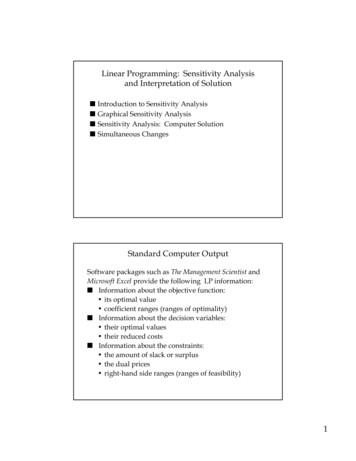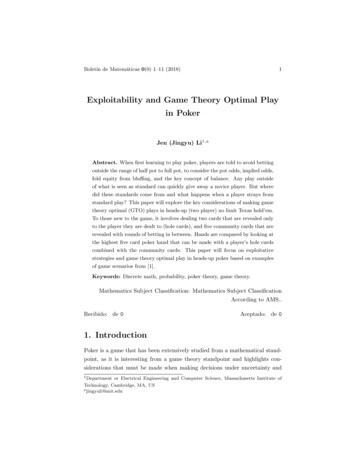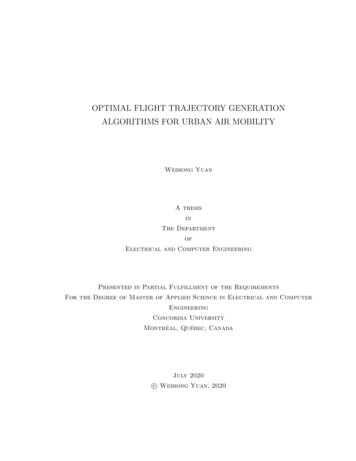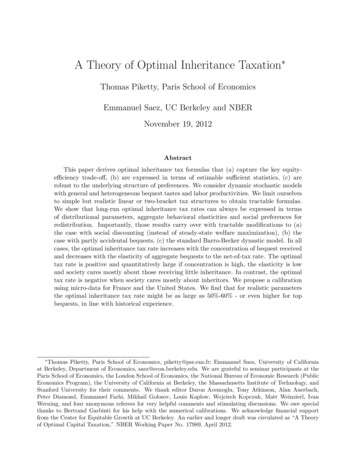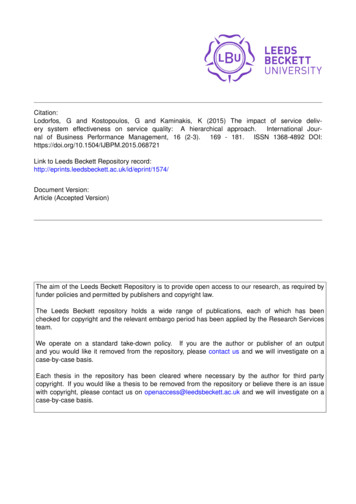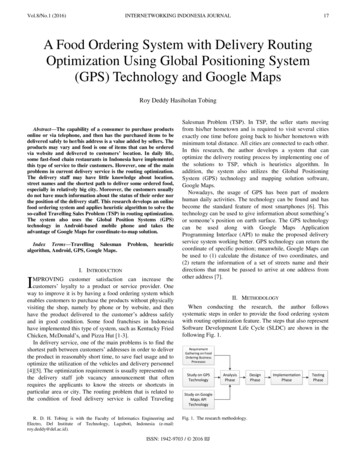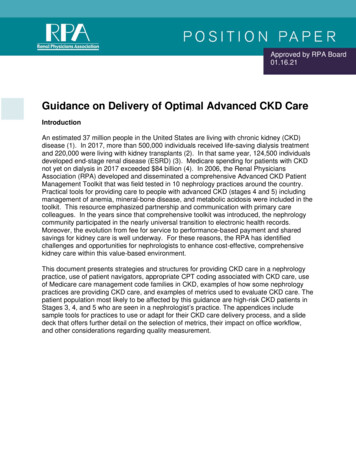
Transcription
1Approved by RPA Board01.16.21Guidance on Delivery of Optimal Advanced CKD CareIntroductionAn estimated 37 million people in the United States are living with chronic kidney (CKD)disease (1). In 2017, more than 500,000 individuals received life-saving dialysis treatmentand 220,000 were living with kidney transplants (2). In that same year, 124,500 individualsdeveloped end-stage renal disease (ESRD) (3). Medicare spending for patients with CKDnot yet on dialysis in 2017 exceeded 84 billion (4). In 2006, the Renal PhysiciansAssociation (RPA) developed and disseminated a comprehensive Advanced CKD PatientManagement Toolkit that was field tested in 10 nephrology practices around the country.Practical tools for providing care to people with advanced CKD (stages 4 and 5) includingmanagement of anemia, mineral-bone disease, and metabolic acidosis were included in thetoolkit. This resource emphasized partnership and communication with primary carecolleagues. In the years since that comprehensive toolkit was introduced, the nephrologycommunity participated in the nearly universal transition to electronic health records.Moreover, the evolution from fee for service to performance-based payment and sharedsavings for kidney care is well underway. For these reasons, the RPA has identifiedchallenges and opportunities for nephrologists to enhance cost-effective, comprehensivekidney care within this value-based environment.This document presents strategies and structures for providing CKD care in a nephrologypractice, use of patient navigators, appropriate CPT coding associated with CKD care, useof Medicare care management code families in CKD, examples of how some nephrologypractices are providing CKD care, and examples of metrics used to evaluate CKD care. Thepatient population most likely to be affected by this guidance are high-risk CKD patients inStages 3, 4, and 5 who are seen in a nephrologist’s practice. The appendices includesample tools for practices to use or adapt for their CKD care delivery process, and a slidedeck that offers further detail on the selection of metrics, their impact on office workflow,and other considerations regarding quality measurement.
2Tenets of optimal CKD care include: Slowing the progression towards ESRDComorbidity care coordination and chronic disease management to reduce thecomplications of progressive CKDPatient-centered education supportive of home modality optionsAdvanced care planning including patient education on conservative (non-dialysis)medical managementShared decision making aimed at developing an individual life plan for renalreplacement therapy to maximize patient quality and quantity of lifeIncreased awareness of and access to pre-emptive transplantationOptimal transition to dialysis when warranted defined as an outpatient transition withthe optimal dialysis accessNephrologist serves as the CKD Principal Care Provider with support from amultidisciplinary kidney care team that may include: Advanced Practitioners (NursePractitioner, Physician Assistant), Dietitian, Social Worker, Medical Assistants, CaseManagers, and Nurse NavigatorsProcesses for achieving these tenets of optimal CKD care: Multidisciplinary CKD Clinic StructureCKD Patient Care NavigatorPopulation Health ManagementStructured Education ProgramLeverage information technology tools including telehealth, remote patientmonitoring, and risk stratification toolsPsychosocial SupportChronic Care ManagementDefined Data Metrics for process improvement insightsCPT Coding Guidelines and RequirementsThe Evolving CKD ClinicCKD care delivery has traditionally been accomplished by visits between a nephrologist andpatient, most often face-to-face in an office setting. Time allocation for these visits rangefrom 10 to 30 minutes to discuss and manage a multitude of challenging, complex medicalissues including patient-specific disease manifestations, kidney-related comorbidities suchas hypertension, volume status, acid-base disturbance, electrolyte disturbance, anemia andmineral-bone disorders. Education about renal replacement therapies including options forhemodialysis, peritoneal dialysis, and kidney transplantation, versus conservative treatmentwithout renal replacement therapy is also provided during these visits. Unfortunately, thebreadth and complexity of kidney patients’ chronic comorbidities, and the real-worldconstraints of episodic care delivery creates a substantive likelihood for missed careopportunities.
3Efforts to overcome the constraints on nephrologists’ bandwidth have driven practices toadd allied medical providers (Nurse practitioners, Physician Assistants) to augment thenumber of face-to-face visits. Care models with co-management by advanced practitionersand nephrologists have positively impacted the effective management of kidney diseasecomorbidities. The addition of advanced nurse practitioners to the nephrology team in a2014-2015 CQI project at the Cleveland Clinic CKD Clinic demonstrated a significant benefitfor measurement of hemoglobin, calcium, phosphorus, 25 vitamin D, intact PTH and lipidprofile (5). Certainly, the addition of non-physician providers increased physician officeavailability, patient education, and coordination of care management opportunities.However, without a paradigm shift in the core CKD care delivery model in the US, overalladoption of home dialysis therapy remains at 10.1% for peritoneal dialysis and 4% for homehemodialysis respectively, while pre-emptive kidney transplantation represents only 2.9% ofall incident ESRD patients (6).Rationale for Patient Care Navigators, a Population Health Paradigm, and InformaticsAdoption of a population health paradigm for delivery of CKD care could prove especiallyvaluable in caring for patients with progressive and/or advanced stage CKD and indecreasing health care disparities. A population health approach does not replace theexisting face-to-face encounters but rather augments that care by creating an identifiedhigher risk patient subset to receive more focused care between scheduled visits. The aimis to meet well-defined clinically relevant outcomes that improve patient health, avoidhospitalizations, and ultimately provide better patient care at lower cost. In this team-based,targeted approach, patient care navigators serve to provide individualized education andguidance to facilitate successful patient interaction with the health care system (7).The CKD Care Navigator’s role can be filled by individuals with no prior medical experience,medical assistants, registered nurses, or advanced practitioners including physicianassistants and nurse practitioners. Local factors such as practice size, available clinic staff,and the desired role and skill set for the CKD clinic model will be important determinants ofwho is best suited to fill the navigator position. Jolly et al. describe their experience usingnon-medical or lay individuals as navigators (6). In all cases, the CKD Care Navigatorbecomes an integral collaborative member of the CKD multi-disciplinary team assisting inat-risk patient identification and overseeing the coordinated management of the identifiedCKD population. Navigators build long-term relationships and trust with the patients, assistthem with education, and serve to improve communication and care coordination among themany providers involved in the patient’s care including the PCP, nephrology team members,and dietitians, vascular surgeons, general surgeons, transplant team members,endocrinologists, and cardiologists. Further, navigators can identify and work to resolve‘everyday’ issues that may not be apparent to clinical staff who are providing care, butwhich can present barriers to care delivery, such as recognizing when a patient may havetwo appointments on the same day in different places, either or both of which aregeographically distant from their home.Patient navigators effectively reduce healthcare access disparities and improve clinicaloutcomes for patients facing cancer diagnoses (8,9). Improved clinical outcomes have alsobeen reported for patients with CKD navigating the transplant process (10). Increasingfocus on the morbidity, mortality, and cost of the transition period from advanced CKD to
4ESRD has emerged in the past decade. Of the roughly 500,000 Medicare patients initiatingdialysis between 2005 and 2009, 77.7 percent started dialysis with a catheter and only 6percent initiated on peritoneal dialysis. Patients were nearly 3 times more likely to die in thefirst 3 months if starting with a catheter rather than a fistula or on peritoneal dialysis (11).Given the complexity of CKD care and the transition to end-stage renal disease (ESRD),efforts to impact the quality of care with chronic care models including multidisciplinary careteams including patient navigators are emerging. Jolly et al. report on their CKD PatientNavigator Program with goals to improve outcomes for patients with stages 3b and 4 kidneydisease (6). The pilot program using trained non-medical providers did not show differencesin eGFR decline nor did they find statistically different results for patients enrolled in theprogram vs. usual care group for dialysis educations referral, vascular access placement,ER visits nor hospitalization rates (12). Nevertheless, the 2019 Advancing AmericanKidney Health Initiative will serve as a catalyst for continued focus by the nephrologycommunity on slowing kidney function decline, ensuring optimal ESRD transition, andachieving increases in home modalities and living donor and pre-emptive kidney transplantselection.Nephrology practices of all sizes should engage in the evolving value-based carereimbursement paradigm. Implementation of a population health approach to CKD care iscritical to achieve success in this model. Thoughtful consideration and planning todetermine the highest priority clinical goals must occur. For example, optimal CKDtransition is likely to be a high priority lever for most nephrology practices. Interventions tosupport optimal starts are likely to include improved coordination with primary care practicesto drive earlier referrals and the addition of risk stratification tools such as the 8 variable, 2year and 5-year Kidney Failure Risk Equation to help determine a high-risk subset of thepractices’ CKD patients (13).After identification, it will be important for clinical leaders to consider their current care gapswithin their existing episodic care CKD model. Common to all practices will be planninginterventions for missed appointments, patients who are lost to follow-up, and patients whoare referred late or not seen in the CKD clinic prior to ESRD. Another critical element is thecreation of a structured, patient-centered CKD education program with educators who arecomfortable with addressing home modalities and kidney transplantation. The aim of aneducation program should be to develop a life-plan for each patient’s future renalreplacement therapy. This plan should include flexibility for changes in the patient’sevolving health and the need for more than a single modality with choices ultimatelyreflecting the goal to maximize quality and quantity of life. Additionally, programs shouldinclude education on conservative (palliative) care pathways and not overlook developmentof resources and partnerships with palliative care provider and peer support organizations.Studies have shown that depression is common in patients with kidney disease and is anindependent risk factor for mortality and morbidity. Peer support can be implemented usingeither telephone-based or group or one-on-one in-person based strategies to help improvepatient acceptance and engagement with the CKD care plan (14). Other priorityinterventions include defining the clinic process for access creation and transplant referral.Partnering with a transplant program that is committed to communicating their evaluationprocess and updating the CKD clinic team on identified barriers is also key to a successfulCKD care model.
5Operational implementation of the CKD care endeavor by practices will depend on carefulplanning of the CKD teams’ workflow to ensure that the navigator receives all incomingpatient clinical information streams. This will allow the patient care navigator to provide thenecessary oversight, additional patient support, and referrals to meet established andupdated care goals between visits. Finally, nephrology practices should consider how theycan leverage codified data from their electronic health systems to update risk estimations,monitor intervention progression and most importantly to evaluate outcomes relating to theirintervention strategies.The transformation from the traditional episodic care model to a CKD model of care thatleverages a population and data-driven approach, structured, patient-centered education,information technology and a multi-disciplinary care team offers a strategy for improvedhome modality adoption and pre-emptive transplantation as well as higher outpatient startswith desired vascular access for patients selecting in-center hemodialysis. Granted, thistransformation presents a financial burden for nephrology practices today. It is thefundamental goal of all value-based care programs to drive better patient care, lower overallcare costs, and reward care models that successfully implement these improved careprocesses. With increasing opportunities for practices to engage in value-based carestructures, the opportunity to share in the cost savings and/or receive higher reimbursementfor better care outcomes will follow. Nephrologists should be aware of variousreimbursement opportunities available to support their CKD care model investmentsincluding chronic care management, transitional care management, and principal caremanagement.Relevant Service Codes and Guidelines to Support CKD CareSummarized below are the relevant CPT or service codes that would be typically used forservices to patients with CKD. Included are not only the evaluation and management (E&M)service codes through which physicians and other health professionals see patients duringoffice visits, but also non face-to-face care management codes and other relevant educationand training services. Provided below are a listing of the codes by code family with briefcode descriptors, relevant CMS coding and documentation guidelines, and links to the CMSguidance documents that provide more detailed information. The RVU and time estimatesreflect the 2021 Medicare Fee Schedule designations.Evaluation and Management (E&M) CodesFor decades, the typical coding structure through which services were provided to CKDpatients were the E&M families of codes, representing office visit services; this has changedsomewhat in recent years with the creation of additional care management service codefamilies. The E&M codes, associated non-facility (office) relative value units (RVUs) andaverage times as established by CPT are listed here:CPT Code99203 (New Pts)9920499205Total Non-Facility RVUs3.264.876.43Time in Minutes356088
699212 (Est Pts)9921399214992151.632.653.765.2516304770For coding purposes, CKD patients will typically receive care corresponding with higherlevel E&M codes, indicating the need for a comprehensive history or exam, and a moderateto high complexity of decision /eval-mgmt-serv-guide-icn006764.pdfChronic Care Management CodesIn recent years CMS has established CPT codes for several families of chronic caremanagement (CCM) services, including those for multiple chronic conditions (CPT codes99490 and 99491) and for multiple complex chronic conditions (CPT codes 99487 and99489). These services should be provided when two or more chronic continuous orepisodic health conditions are present that are expected to last 12 months or more (or untildeath) and place the patient at significant risk of death, acuteexacerbation/decompensation, or functional decline.Required activities associated with these services to address the medical and/orpsychosocial needs of the patient include establishing, implementing, revising, and/ormonitoring the patient care plan. Patient consent must be obtained in advance, and thepatient must be engaged, aware of applicable cost sharing, and has the right to stop at anytime.NOTE: CCM services cannot be provided to patients receiving care represented by theESRD monthly capitated payment (MCP) code family.CPT Code99490994919948799489Non-Facility RVUs1.182.362.631.26Time in Minutes20306030 ds/chroniccaremanagement.pdfPrincipal Care Management CodesFor the 2020 Medicare Fee Schedule, CMS created two G-codes for principal caremanagement of a single chronic condition, G-2064 (physician management) and G-2065(clinician management directed by a physician).CPT CodeG2064G2065Non-Facility RVUs2.591.11Time in Minutes30 (At least)30 (At least)
7Like the other care management services, the PCM codes can only be billed by onepractitioner per month and include the same requirements relating to patient consent (i.e.,documented consent, awareness of cost-sharing and the ability to stop at any time) as wellas a separately billable initiating visit, use of a certified EHR system, and a written diseasespecific care management plan that is updated as appropriate. Regarding cost-sharing,some nephrology practices have reported that this has proven to be a barrier to broader useof PCM services. Like the CCM codes, these services cannot be provided to ESRDpatients. Services can be provided by PCP or specialist but only one PCM code can bebilled per month, thus the nephrology practice should consider collaborating with its referralbase so that PCPs don’t feel as if the practice is “poaching” PCM patients. To this end, thenephrology practice may consider limiting its use of PCM services to CKD 4 and 5, andperhaps transplant or active immunosuppression patients.Among the clinical work activities that would typically be included in the 30 minutesassigned to the codes would be chart review, communication with other team members,medication reconciliation, phone call with patients, anemia management, medicationmanagement. Issues that could or should likely be addressed monthly include but are notlimited to: Modality education: what format and when? Have they decided on a plan? Date oflast home visit? Any barriers to home therapy?Access planning: what is the plan, what Estimated glomerular filtration rate (eGFR)triggers the next step? If they have an access, when was it placed, by whichsurgeon, when was the last surveillance, and are there any issues?Anemia: Hgb in range? When was it last checked? Are iron stores replete? Is thepatient getting an ESA? If so, from whom? Is the patient getting injections and labsin timely fashion?Bone disease: PTH in range? Calcitriol needed?Metabolic acidosis: CO2 in range? Has bicarbonate therapy been prescribed?Should referral to a renal dietician (RD) be made for lower protein diet?Hyperphosphatemia: In range? When checked? Binder needed? RD referralneeded?Hypertension: in range? ACEi/ARB being used or why not if otherwise indicated?Hep B vaccination: Is it needed? Where are they in the series? Not responded?Albumin: Is the patient in range? Interventions needed?Transplant: Has a referral been made, to where, needed tests, decision made?Have medications been checked and are all appropriate for CKD?Hyperkalemia: Is it in range? Treatments (including RAAS inhibition avoidance, loopdiuretic, bicarbonate therapy, K binders)It is worth noting that the difference between the PCM codes and the CCM codes is that thePCM codes are for care associated with a single complex condition, while the CCM codesare for the care of multiple (two or more) chronic continuous or episodic conditions.Additionally, there are differences in the average times and assigned RVUs as noted above.
8NOTE: As of mid-2020 the CMS guidance on the PCM codes had not been issued. Thepassage on the codes which provides more detail on the services from the 2020 MedicareFee Schedule can be viewed here.Transitional Care Management CodesSince January 1, 2013, the Medicare Fee Schedule has included transitional caremanagement (TCM) codes that provide reimbursement for non-face-to-face care providedfor the period when patients are transitioning from an acute care setting back into thecommunity. These services can be critically important in the effort to avoidrehospitalizations of CKD patients.CPT Code9949599496Non-Facility RVUs5.968.07Time PeriodWithin 14 Days of DischargeWithin 7 Days of DischargeThe TCM codes are for care management immediately post hospitalization (either anoutpatient or inpatient hospital stay, or a rehabilitation stay in a long-term acute care facility,a skilled nursing facility, or an acute rehabilitation facility). Use of the TCM codes requirecontact with the patient/caregiver within 2 business days (and thus it is generally necessaryto know your patient has been admitted), and a face-to-face visit and medicationreconciliation within 7-14 days; the medication reconciliation and management must occurno later than the date of the face-to-face visit. Once the patient is discharged from thehospital, staff should obtain hospital records (history and physical, discharge summary,labs, other relevant notes or studies) to review at the face-to-face visit. Medicationreconciliation must be performed at the face-to-face visit, so the dischargesummary/instructions are important. Medical decision making for the TCM codes is definedby the same guidelines for E&M services, and only one provider may bill in 30-day period.The TCM codes are on CMS’ approved telehealth list. Importantly, since January 1, 2020TCM services can be billed concurrently with the ESRD MCP codes.NOTE: At press time the CMS guidance document on the TCM codes was under revisionand unavailable; below is a similar document from the American College of caremanagement-tcm-codesKidney Disease Education ServicesAs part of the 2010 Medicare Fee Schedule, CMS created legislatively mandated servicecodes for kidney disease education (KDE) services that would likely be appropriate toprovide to most if not all CKD patients. G0420 is the service code for one hour of face-toface KDE services related to the care of CKD, for the individual, per session; G0421 shouldbe billed for face-to-face services related to the care of CKD for one hour of KDE groupsessions.CPT CodeG0420Non-Facility RVUs3.27Time in Minutes60
9G04210.7860Key aspects of the KDE services include: Only stage 4 CKD patients are eligible for these services in fee for service Medicare(the benefit is not available to stage 3 or stage 5 patients); stage 5 patients may beincluded in the Kidney Care First (KCF) and Comprehensive Kidney CareContracting (CKCC) voluntary kidney models.The service should be billed in increments of 1 hour (must be more than or equal to31 minutes);Furnished, upon referral of the physician managing the beneficiary’s kidneycondition, by a qualified person: Physician, NPP, CNS, etc.;Is listed as telehealth service (this predates the COVID-19 related expansion of theapproved telehealth list due to the public health emergency);No explicit restriction on being provided same day as E/M;Not incident-to (i.e., the NPP paid full amount);Content should include comprehensive information regarding management of:o Comorbidities and treatments to delay disease progressiono Prevention of uremic complicationso Diet & Nutritiono Therapeutic optionso Treatment modalitieso AlternativesThe program should be tailored to meet individual patient needs;The practitioner should develop and implement outcomes assessments designed tomeasure beneficiary knowledge about CKD.Practices considering the establishment of a KDE program should be aware that there aredeveloped curricula available that could be used or adapted for local use, so to the extentthat getting started seems daunting, resources do exist to facilitate this wnloads/MM6557.pdfHome Dialysis TrainingComprehensive CKD care may necessitate the use of home dialysis training for appropriatepatients. Medicare covers home dialysis training for both a completed course (using CPTcode 90989) and an incomplete course (using CPT code 90993). These services do nothave RVUs assigned to them (and thus do not appear in the Medicare Fee Schedule) butrather are paid flat fees of 500 for 90989 and 20 per session for 90993.A completed course (90989) is 25 home dialysis training sessions (although 25 trainingsessions are not required to bill for the completed course). The physician must have directparticipation in the training to bill the service, and the service can be billed in the samemonth as the patient’s monthly capitated payment (MCP). Training of a family member or
10other designee is approved if the patient has physical, cognitive, or other developmentallimitations. An incomplete course can be billed using 90993 and is prorated at 1/25thpayment of the completed course (i.e., 20 per session). The allowed dollar amount for bothservices is a flat fee, subject to deductible and co-insurance requirements.NOTE: CMS guidance on billing for home dialysis training is not available. Below is a link toone of the Medicare Administrative Contractors providing billing guidance on home tto/providers.nsf/DocsR/Providers JJ%20Part%20B Browse%20by%20Specialty Nephrology BAAN777078?openRemote Patient Monitoring CodesOver the past several years CMS has established coverage for remote patient monitoring inthe fee schedule, with separate codes for set up, supplies/transmission/reporting, and twotimed codes for the first 20 minutes of RPM services and additional time. Some nephrologypractices have been using these codes in combination with the chronic care managementservice codes to optimize real time physiologic monitoring of the patient’s condition.CPT Codes99453994549945799458Non-Facility RVUs0.551.811.461.18TimeN/AN/A1st 20 minutes 20 minutesOther coding issues to be aware of in billing the RPM codes include: (1) only physicians andNPPs who are eligible to furnish E/M services may bill RPM services; (2) CPT code 99457can be provided as an ‘incident-to’ service; and (3) CPT codes 99457 and 99458, an“interactive communication” is a conversation that occurs in real-time and includessynchronous, two-way interactions that can be enhanced with video or other kinds of dataas described by HCPCS code G2012.Additionally, as part of the 2021 rulemaking cycle, CMS is proposing that after the COVIDpublic health emergency it will again require that an established patient-physicianrelationship exist for RPM services to be furnished but is also proposing that it will bepermanent policy to allow consent to be obtained at the time that RPM services arefurnished. Finally, CMS is proposing to clarify that the medical device supplied to a patientas part of CPT code 99454 must be a medical device as defined by Section 201(h) of theFederal Food, Drug, and Cosmetic Act, that the device must be reliable and valid, and thatthe data must be electronically (i.e., automatically) collected and transmitted rather thanself-reported.CKD Care Delivery in Real-World Nephrology PracticesWhile CMS/Medicare payment policies are in general applied nationally, heterogeneity inphysician practice setting, size, and geography and other factors will invariably foster thedevelopment of many different approaches to providing CKD care based on these
11dynamics. Listed below are three vignettes that describe approaches used to provide CKDcare by three geographically diverse nephrology practices.Vignette 1Practice structure: Three nephrologists and two NPs. We use the hospital's EMR whichmost community doctors use. Our CKD clinic takes place in three locations throughout thecounty.We provide comprehensive CKD care (with a focus on our CKD4 and 5 patients) centeredaround three goals.1. Preserve the remaining kidney function as long as possible.2. Protect our patients from complications of kidney disease.3. Prepare each patient for kidney failure with a plan that encompasses transplant,RRT, or conservative renal care.The principal care management (PCM) program is a cornerstone of our efforts. Each monthour NP contacts each PCM patient. Using our county-wide EMR she is also able to reviewthe work of the rest of the patient's care team. Each month the specific metrics to our threegoals are updated and interventions can be performed by the NP or brought to the doctors’attention if needed. Additionally, the patient builds a strong relationship with the nephrologycare team that will support them if they do need to undergo RRT.Vignette 2Practice structure: 10 Nephrologists and four Advanced Practice Nurses (APNs). We havea full clinical nephrology practice of office, hospital, outpatient dialysis, kidney ultrasoundand Interventional Nephrology, but we do not have kidney transplantation in our community.We encourage outpatient consultation for Chronic Kidney Disease (CKD) stages 3, 4 and 5.The initial consultation and 2nd visit are done by the nephrologist. Thereafter, the patientalternates between the doctor and the APN. 4 return visits are seen per hour, anddocumentation is via a large commonly used EMR. At the time of the office visit, the patientis “roomed” by a medical assistant (MA), who does a review of systems, medicationreconciliation, and takes vital signs. Our EMR office note is sent to the patient’s primarycare doctor (PCP) and specialists. CK
An estimated 37 million people in the United States are living with chronic kidney (CKD) disease (1). In 2017, more than 500,000 individuals receivedlife-saving dialysis treatment and 220,000 were living with kidney transplants (2). In that same year, 124,500




